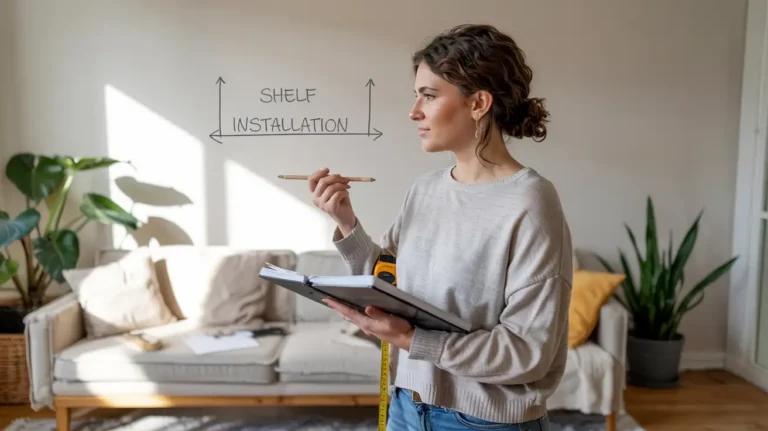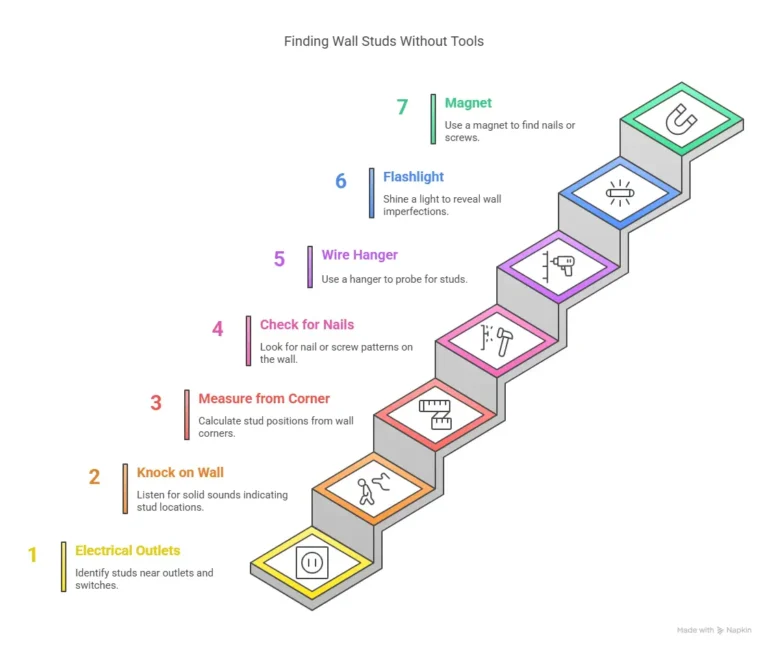Ever stood there staring at a blank wall, wondering where the heck the stud is? Yep—been there. If you’re asking, how to find a stud without a stud finder, the good news is: you absolutely can. No fancy gadgets required—just some good ol’ DIY tricks (and maybe a fridge magnet).
Table of Contents

What Is a Wall Stud?
Alright, let’s break it down. A wall stud is a vertical wooden or metal beam located behind drywall that supports your walls and anchors fixtures like shelves or TVs. Basically, studs are the bones of your wall.
They’re usually spaced 16 to 24 inches apart, running vertically from floor to ceiling. Drywall gets screwed directly into these studs. So if you’re hanging anything heavier than a picture frame, you’ll want to hit the stud (literally).
Why Do I Need to Know How to Find a Stud in the Wall?
Look, drywall is great—until you try to hang something on it. You need studs for:
- Mounting shelves or TVs
- Installing cabinets or mirrors
- Hanging heavy art or wall decor
Trying to wing it and just nail into the wall wherever? Risky move. You could end up with:
- Holes in the wrong spots
- Cracked drywall
- A wobbly shelf that drops your fancy decor at 2am
That’s why learning how to find studs is a total must for any DIYer, renter, or curious homeowner.
7 Ways to Find Wall Studs Without a Stud Finder

You don’t need the best stud sensor or some top-rated gadget from Beam Finder Lowes. You just need a few tried-and-true methods. Here’s how:
1. Tap and Listen for a Hollow Sound
This one’s as old school as it gets. Gently knock on the wall and listen:
- Hollow = empty space
- Solid = stud behind it
Want to double-check? Tap every few inches horizontally until the sound shifts. That change? Likely a stud.
Pros: Fast and requires zero tools.
Cons: Not always 100% accurate, especially with textured walls.
2. Look for Electrical Outlets and Light Switches
FYI: Outlets and light switches are typically mounted on the side of a stud. So, start from there:
- Remove the cover plate
- Peek inside (carefully!) and see which side the box is attached to
- Measure 16 inches in either direction
Boom—you’ve just found the first stud.
3. Measure from a Corner (Studs Are Typically 16 Inches Apart)
Here’s the most mathematically satisfying trick. Most studs are 16 inches apart (center to center). So, grab a tape measure and:
- Start from a corner of the wall
- Mark every 16 inches horizontally
- Tap those spots to confirm
If your house is older, you might find studs every 24 inches—so don’t panic if the first few tries are missed.
4. Check for Nail Pops or Bumps on the Wall
Some walls have subtle hints left behind by builders:
- Tiny bumps under paint? Might be finish nails
- Slight lines or dimples? Could mark the center of a stud
Run your fingers slowly across the wall, feeling for inconsistencies. It’s kinda like wall Braille.
5. Use a Flashlight to Spot Wall Texture Changes
This method feels kinda spy-movie-esque. Angle a flashlight along the wall and look for:
- Subtle indentations
- Nail lines
- Paint pattern shifts
These can all signal where the stud lives. Works best on smooth or lightly textured walls.
6. Use a Wire Hanger or Small Nail
Don’t go full demolition mode, but if you’re okay with tiny holes:
- Straighten a wire hanger (or use a thin nail)
- Gently poke into the wall
- Feel for resistance or wood shavings
But hold up—watch out for wires and pipes. Avoid the area directly above or below outlets, switches, and plumbing.
7. Use a Magnet to Detect Screws or Nails
Want a DIY magnetic stud finder? You got one in your kitchen.
- Grab a strong fridge magnet
- Slide it slowly across the wall
- When it sticks slightly? You’ve hit a screw that’s anchored into a stud
This trick works surprisingly well, especially if you use rare-earth magnets. And yep, it’s the best way to find studs without stud detector tools.
Final Thoughts
So, yeah—you really don’t need a gadget to figure out how to find a stud without a stud finder. With a bit of patience and these old-school tricks, you can hang that shelf, mount that TV, or tackle that weekend DIY project like a total boss.
Just remember: be gentle, measure smart, and maybe keep that magnet handy. Still not confident about drilling into your walls? No shame in that. Sometimes it’s better to call in the pros. Check out our Handyman Services and let us handle the heavy lifting.
FAQs
Can I find a stud without a stud finder?
Yes, you can use methods like knocking, measuring from corners, or using a magnet to find studs without a stud finder.
How do you manually find studs?
Tap on the wall to listen for solid areas, measure 16 inches from a corner, or inspect around outlets where studs are likely located.
How do you make a homemade stud finder?
Use a strong magnet attached to a string or mounted in a block of foam. Slide it along the wall to detect screws or nails in the studs.
What to use if you don't have a stud?
Use wall anchors or toggle bolts to safely hang items on drywall, but avoid mounting heavy objects without proper support.
How do I tell if I hit a stud?
If the drill resists slightly or you see wood shavings coming out, you’ve likely hit a stud. Screws will also feel more secure in a stud.







